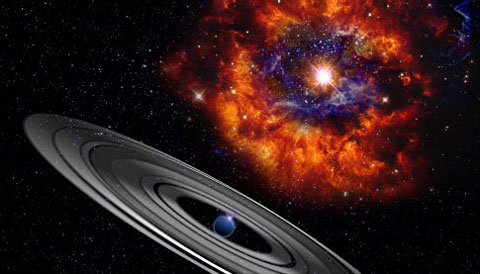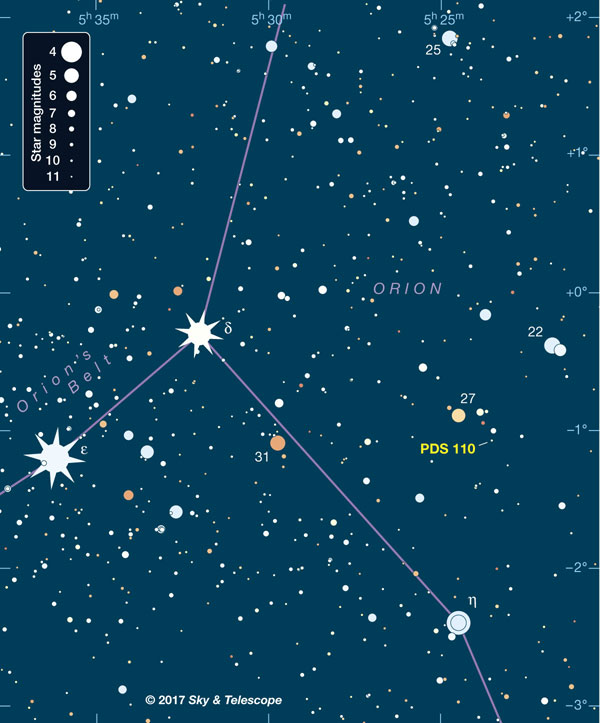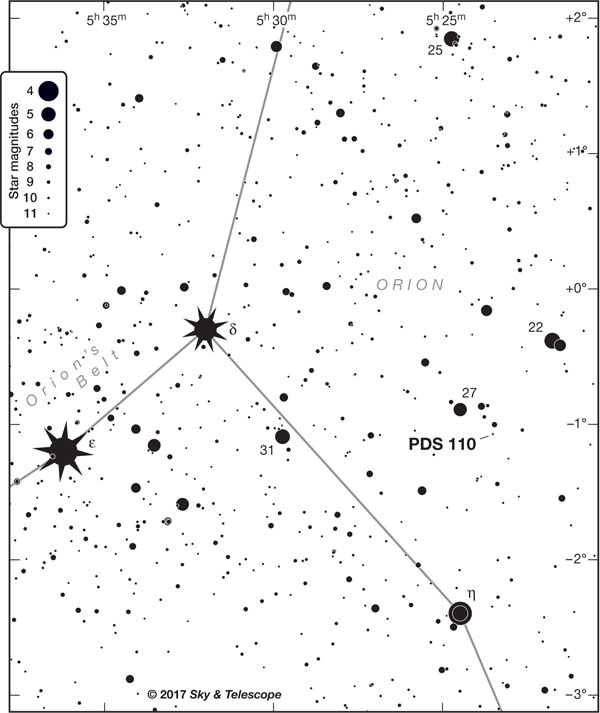The possible discovery of a massive ringed planet in Orion needs confirmation — and amateur astronomers can help.
Update (June 4, 2019): The team has issued a statement that no ring transit was seen when expected. Professional and amateur observations confirm that whatever caused the dips in 2008 and 2011, it was not a permanent feature. The team continues to monitor the star via amateur observations submitted to the AAVSO and long-term monitoring with the ASAS-SN network. Read more here.
Update (June 8, 2017): Finder charts are now available! Scroll down to the bottom for color and black-and-white versions.
Do you want to help observe a giant planet orbiting a young star in Orion?

University of Warick, UK
Professional astronomers are once again teaming up with amateur astronomers all over the world to capture the eclipse of PDS 110, a young star in Orion orbited by a large planet (or perhaps a brown dwarf) that is itself surrounded by a ring system and moons.
Perhaps you remember the case of J1407 — that system featured a gigantic ring system full of gaps, presumably from exomoons. The PDS 110 system, detailed by Hugh Osborn (University of Warwick, UK) in the Monthly Notices of the Royal Astronomical Society, shows some similarities to the J1407 companion.
PDS 110 is a star in the Orion OB1a association, northwest of Orion’s belt. The association, like many others in Orion, contains young, massive stars less than 20 million years old. PDS 110 itself is estimated to be 7 to 10 million years old and is still growing, accreting material from its natal cloud. The star’s mass is 1.6 times that of the Sun, but unlike the Sun, it emits a lot of light at infrared wavelengths, probably emitted by the surrounding gas and dust heated by the infant star’s radiation. Since it’s relatively bright, it has been the object of surveys for decades.
Osborn and his team began poring over data from a few automated surveys, including the Wide Angle Search for Planets (WASP) and Kilodegree Extremely Little Telescope (KELT), when they noticed some interesting events in brightness of the star over time. In November 2008 and January 2011, the light coming from PDS 110 dimmed dramatically for a couple weeks, to about 30% its usual value.
Osborn ruled out other explanations for these dips, including clumps of dust orbiting the star — any such clumps wouldn't last, they'd quickly spread out along their orbits. Instead, he suggests that there is a companion with between 2 and 80 times the mass of Jupiter orbiting PDS 110 every 808 days. This period corresponds to an average distance from the star of 2 astronomical units (twice the average distance between Earth and the Sun).
What makes this system so fascinating is the nature of the eclipses, as seen by their shape in the light curve that traces the star’s brightness over time. While lone planets cause a star’s brightness to dip steadily and symmetrically, the two eclipses observed so far in the PDS 110 system are far deeper than your typical exoplanet transit, and they’re ragged too, indicating some kind of structure to the eclipsing object.
“What’s exciting is that during both eclipses, we see the light from the star change rapidly, and that suggests that there are rings in the eclipsing object, but these rings are many times larger than the rings around Saturn,” says coauthor Matthew Kenworthy (Leiden University).
Similar behavior was seen in the J1407, which Kenworthy discovered, but that system only has one observed eclipse. PDS 110 has exhibited this behavior twice, and if Osborn’s hypothesis is correct, the the companion object and its massive set of rings will once again eclipse the star in September 2017. The ring system appears to be full of gaps and variations in density, which could signal exomoons, as in the J1407 system.
The team will be producing finder charts and instructions for observers to be released prior to September, and we will link to that information here as it becomes available. If the period is confirmed, PDS 110 will stand alone as the only confirmed ringed companion to a star outside our solar system. It will likely be the target of follow-up spectroscopy, which will enable Osborn and colleagues to more precisely estimate the companion’s mass, as well as ALMA observations that may reveal material or companions in more distant orbits around the star.
Finder Charts


 2
2









Comments
Graham-Wolf
June 8, 2017 at 9:39 pm
WOW!!
Jumping Orionid massive-ringed-planets, Batman!
Let's get out the mighty bat-scope, and hunt this one down.
Saturn is in serious trouble, Robin....
Mirthfully yours,
Graham W. Wolf
46 South, NZ
You must be logged in to post a comment.
Wayne
June 9, 2017 at 4:59 pm
Any chance this is a multi-planet system -- two or three planet-sized objects orbiting about one another?
You must be logged in to post a comment.
You must be logged in to post a comment.